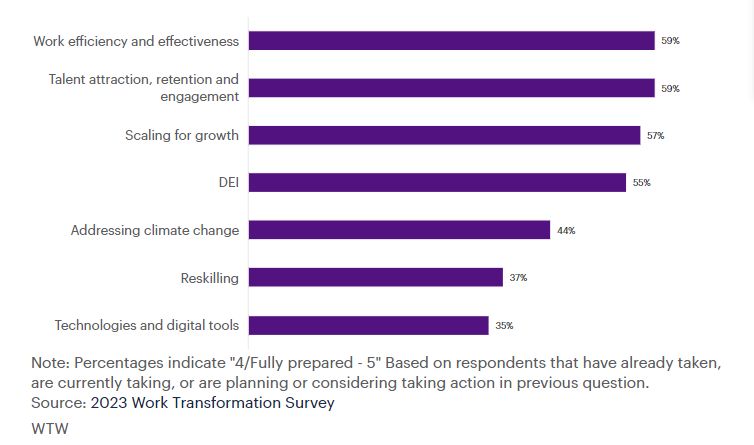Global highlights from our Work Transformation Survey
Exploring the impact of AI, digital technologies and changing workforce dynamics on organizations around the world.
Artificial intelligence (AI) and digital technologies
AI and digital technologies are reshaping the workplace. 35% of work will be done by automation in three years, almost twice as much as three years ago. Employees must adapt to new tools and ways of working.
Shifts in demographics, like aging populations, are influencing work transformation by altering the composition and expectations of the workforce. Organizations need to adjust their strategies to manage a more diverse workforce with varying needs and skills.
Changing demographics
Changes in labor force participation, such as varying employment rates and the rise of part-time and freelance work, are creating a more fluid job market. 52% of employers expect to see opportunities to create value through new sources of talent. This shift demands that businesses adopt more flexible employment practices and integrate a broader range of employment types into their workforce planning.
Shifts in labor force participation
Challenges facing organizations
- Cost pressures and high inflation: Organizations are operating under significant financial stress due to continued high inflation, which impacts operational costs and overall budgeting.
- Talent shortages: There's a critical shortage of talent, especially individuals who have the necessary skills to interact with new technologies and adapt to new ways of working. This shortage makes it imperative for organizations to strategically place the right talent in the right roles.
Organizations need to keep pace with current work requirements while forecasting future requirements
77%
of organizations are focusing on talent acquisition, retention and engagement
But fewer than 2 in 5 respondents are prepared to deal with the effects of new technologies and digital tools or reskilling of employees.
Current actions around work transformation
- Talent attraction, retention and engagement
- Diversity, equity and inclusion
- Scaling for growth
Already taken action
- Work efficiency and effectiveness
- Talent attraction, retention and engagement
- Diversity, equity and inclusion (DEI)
Currently taking action
- Reskilling
- Technologies and digital skills
- Addressing climate change
Planning or considering taking action
5 steps to effectively navigate the challenges of work transformation
01
Identifying critical talent requirements
Develop strategies for talent acquisition and retention, along with HR programs and policies to meet these critical talent requirements.
02
Understanding market dynamics
Conduct research to understand the market dynamics by geography to ensure actions align with market needs. Utilize external providers and benchmarks for a tailored approach.
03
Evaluating the organization's technology landscape
Compare your current technology landscape with emerging technologies to identify necessary talent and workforce management interventions, enhancing efficiency and supporting growth.
04
Assessing specialized internal capabilities
Evaluate the readiness of specialized units like HR and business partners to support organizational design needs, ensuring they understand and can implement new work models that align with evolving business models.
05
Measuring readiness for work transformation
Measure the organization's readiness for change by identifying success factors, using external insights and benchmarks to develop action plans that facilitate effective communication and training for change leaders and managers.
The dynamics of work are truly changing, and this will likely mandate greater flexibility, adaptation and innovation in the way we work.
Ready to transform your organization? Contact one of our experts today to harness the full potential of your workforce and drive strategic change.
The content of this article is intended to provide a general guide to the subject matter. Specialist advice should be sought about your specific circumstances.


